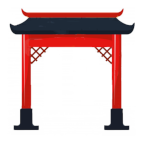| Meaning |

coming out 出
|
| Explanation |
|
Used in these characters:
|
|
出
|
 |
|
JLPT HSK 1 |
|
| to come out, to go beyond, to occur, to rise
|
Two mountains 山 behind each other (traditionally "sent behind the mountains" for exile)
Behind a mountain another comes out.

|
|
|
|
础
|
 |
|
JLPT HSK 4 |
|
| foundation, base
|
Left: stone 石 (At the cliff 厂 is a stone 口), right: coming out 出 (Two mountains 山 coming out one after the other.)
The stone from which something comes out is: a foundation.

|
|
|
|
屈
|
 |
|
JLPT HSK 5 |
|
| crouch, bent, crooked, to feel wronged
|
Top: buttock from the side 尸, bottom: come/go out 出 (Two mountains 山 coming out one after the other)
("plumber's crack or smile", which refers to the visible butt-crack if a guy with a too short shirt crouches.) The buttock (= the crack) comes out when stooping(=bowing).

|
|
|
|
拙
|
 |
|
JLPT HSK 6 |
|
| clumsy, awkward, dull, inelegant, (polite) my
|
Left: hand 扌, right: come/go out 出 (Two mountains 山 coming out one after the other)
(i.e. at a traditional robe:) If a hand comes out (or sticks out), it looks clumsy and awkward.

|
|
|
|
咄
|
 |
|
JLPT no HSK |
|
| aggressive, noise of rage, to cry out in anger
|
Left: mouth 口, right: to come out 出 (Two mountains 山 coming out one after the other)
When the mouth 'comes out', you appear: aggressive.

|
|
|
|
祟
|
 |
|
JLPT no HSK |
|
| evil spirit, evil influence
|
Top: coming out 出 (Two mountains 山 coming out one after the other), bottom: to show 礻/示 (image of an altar 示)
It comes out on the altar: the evil spirit.

|
|
|
| Radicals are shown here that are similar either in appearance or meaning. |  |
|
At the page you get the memory phrases for learning the Chinese Hanzi. If you are learning the Japanese kanji, please follow this link. |
List of the characters |
List of the radicals
|

